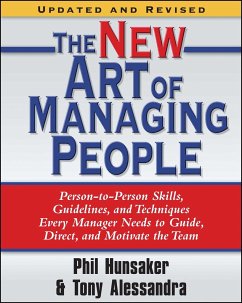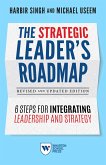Tony Alessandra, Phillip L Hunsaker
The New Art of Managing People, Updated and Revised
Person-To-Person Skills, Guidelines, and Techniques Every Manager Needs to Guide, Direct, and Motivate the Team
21,99 €
inkl. MwSt.
Versandfertig in über 4 Wochen

11 °P sammeln
Tony Alessandra, Phillip L Hunsaker
The New Art of Managing People, Updated and Revised
Person-To-Person Skills, Guidelines, and Techniques Every Manager Needs to Guide, Direct, and Motivate the Team
- Broschiertes Buch
- Merkliste
- Auf die Merkliste
- Bewerten Bewerten
- Teilen
- Produkt teilen
- Produkterinnerung
- Produkterinnerung
A fully revised and updated edition of the management classic which offers updates on crucial guidelines and techniques for developing the interpersonal skills necessary to improve relations with employees, assessing and improving current working situations, understanding the differences between people, and numerous other methods for creating a positive work environment and increasing productivity and profitability. In addition, the eight new chapters reflect the latest developments in the field including Planning and Goal Setting, Developing Ethical Guideposts, Valuing Diversity and Promoting…mehr
Andere Kunden interessierten sich auch für
![Managing People, Culture and Data in the Modern Organisation Managing People, Culture and Data in the Modern Organisation]() Jovina AngManaging People, Culture and Data in the Modern Organisation15,99 €
Jovina AngManaging People, Culture and Data in the Modern Organisation15,99 €![Decent People, Decent Company Decent People, Decent Company]() Robert L TurknettDecent People, Decent Company31,99 €
Robert L TurknettDecent People, Decent Company31,99 €![The Strategic Leader's Roadmap, Revised and Updated Edition The Strategic Leader's Roadmap, Revised and Updated Edition]() Harbir SinghThe Strategic Leader's Roadmap, Revised and Updated Edition18,99 €
Harbir SinghThe Strategic Leader's Roadmap, Revised and Updated Edition18,99 €![The Complete Project Manager The Complete Project Manager]() Randall EnglundThe Complete Project Manager61,99 €
Randall EnglundThe Complete Project Manager61,99 €![Engaging the Heart for People, Performance, and Profit: Seven Competencies of Compassion@Work Engaging the Heart for People, Performance, and Profit: Seven Competencies of Compassion@Work]() R. Brayton BowenEngaging the Heart for People, Performance, and Profit: Seven Competencies of Compassion@Work15,99 €
R. Brayton BowenEngaging the Heart for People, Performance, and Profit: Seven Competencies of Compassion@Work15,99 €![Way of the Seal Updated and Expanded Edition Way of the Seal Updated and Expanded Edition]() Mark DivineWay of the Seal Updated and Expanded Edition15,99 €
Mark DivineWay of the Seal Updated and Expanded Edition15,99 €![Ask the Right Questions, Hire the Best People, Fourth Edition Ask the Right Questions, Hire the Best People, Fourth Edition]() Ron FryAsk the Right Questions, Hire the Best People, Fourth Edition15,99 €
Ron FryAsk the Right Questions, Hire the Best People, Fourth Edition15,99 €-
-
-
A fully revised and updated edition of the management classic which offers updates on crucial guidelines and techniques for developing the interpersonal skills necessary to improve relations with employees, assessing and improving current working situations, understanding the differences between people, and numerous other methods for creating a positive work environment and increasing productivity and profitability. In addition, the eight new chapters reflect the latest developments in the field including Planning and Goal Setting, Developing Ethical Guideposts, Valuing Diversity and Promoting Change. Management is an ever-expanding area of study, and every business school professor, executive, and aspiring manager should read this essential guide to creating a friendly and productive working atmosphere.
Hinweis: Dieser Artikel kann nur an eine deutsche Lieferadresse ausgeliefert werden.
Hinweis: Dieser Artikel kann nur an eine deutsche Lieferadresse ausgeliefert werden.
Produktdetails
- Produktdetails
- Verlag: Free Press
- Revised, Updated edition
- Seitenzahl: 368
- Erscheinungstermin: 23. Dezember 2008
- Englisch
- Abmessung: 231mm x 185mm x 28mm
- Gewicht: 499g
- ISBN-13: 9781416550624
- ISBN-10: 1416550623
- Artikelnr.: 23576445
- Herstellerkennzeichnung
- Libri GmbH
- Europaallee 1
- 36244 Bad Hersfeld
- gpsr@libri.de
- Verlag: Free Press
- Revised, Updated edition
- Seitenzahl: 368
- Erscheinungstermin: 23. Dezember 2008
- Englisch
- Abmessung: 231mm x 185mm x 28mm
- Gewicht: 499g
- ISBN-13: 9781416550624
- ISBN-10: 1416550623
- Artikelnr.: 23576445
- Herstellerkennzeichnung
- Libri GmbH
- Europaallee 1
- 36244 Bad Hersfeld
- gpsr@libri.de
Phil Hunsaker and Tony Alessandra
Contents
Preface
1 Building Productive Managerial Relationships
The Interactive Approach to Managing People
Principles of Interactive Management
Increasing Employees' On-The-Job Effectiveness
Understanding People
Interactive Communication Skills
Constructive Manipulation
What to Expect
ADJUSTING EFFECTIVELY TO PERSONAL STYLE DIFFERENCES
2 Learning How to Learn
The Learning Model
Dimensions of Learning
Individual Learning Styles
Learning Modes
Learning Style Types
Characteristics of Learning Style Types
Learning Styles and Problem Solving
Guidelines for Managing the Learning Process
3 Doing Unto Others
Behavioral Styles and Interpersonal Problems
Unproductive Behavior
Identifying Behavioral Styles
Behavioral Flexibility
Behavioral Styles and Interactive Management
4 Deciding How to Decide
The Dimensions of Decision Style
Four Basic Decision Styles
Back-Up Styles
Mixed Styles
Characteristics of Each Decision Style
Is There a "Best" Decision Style?
Advantages of Each Style
Problems of Each Style
Coping Productively with Other Styles
Applications to Integrative Management
5 Analyzing Transactional Styles
Ego States
Transactions
Strokes
Life Positions
Trading Stamps
Use of Time
Games
Stopping Games
Interventions
TA and Interactive Management
INTERACTIVE COMMUNICATION SKILLS
6 The Art of Questioning
Why People Ask Questions
Types of Questions
Questioning Strategies and Techniques
7 The Power of Listening
Gripes about Managers
Categories of Listeners
Barriers to Effective Listening
The Nineteen Commandments of Power Listening
Exercises to Improve Your Listening Skills
Listening and Interactive Management
8 Projecting the Appropriate Image
Components of Image
Image and Interactive Management
9 Communicating Through Voice Tones
10 Using Body Language Effectively
Interpreting Body Language Gestures
Interpreting Gesture Clusters
Using Body Language
11 Spatial Arrangements Say Things
Territory
Environment
Things
Using Territory and Environment to Facilitate Communication
Personal Space
Interpersonal Space
Interpersonal Space Strategies
Special Arrangement Determinants
Implications for Interactive Management
12 How Your Use of Time Talks
Accuracy
Scarcity
Repetition
13 Making Sure with Feedback
Types of Feedback
Using Feedback Effectively
INTERACTIVE PROBLEM-SOLVING
14 Problem-Solving Together
Problem Definition
Action Planning
Implementation
Follow-Through
15 Defining the Problem
Step 1: Establish Trust Bond
Step 2: Clarify Objectives
Step 3: Assess Current Situation
Step 4: Identify Problems
Step 5: Define and Analyze Problems
Step 6: Agree on Problems to be Solved
16 Developing Action Plans
Step 1: Check the Trust Bond
Step 2: Establish Decision-Making Criteria
Step 3: Develop Action Alternatives
Step 4: Evaluate Action Alternatives
Step 5: Decide on an Action Plan
17 Implementing Action
Step 1: Check the Trust Bond
Step 2: Assign Tasks and Responsibilities
Step 3: Set Up an Implementation Schedule
Step 4: Reinforce Commitment and Activate
18 Following Through
Step 1: Check the Trust Bond
Step 2: Establish Criteria for Success
Step 3: Determine How to Measure Performance
Step 4: Monitor Results
Step 5: Take Corrective Action
19 What Do You Do with What You've Learned?
Use the Interactive Management Problem-Solving Process to Improve Your
Interactive Management Skills
Index
Preface
1 Building Productive Managerial Relationships
The Interactive Approach to Managing People
Principles of Interactive Management
Increasing Employees' On-The-Job Effectiveness
Understanding People
Interactive Communication Skills
Constructive Manipulation
What to Expect
ADJUSTING EFFECTIVELY TO PERSONAL STYLE DIFFERENCES
2 Learning How to Learn
The Learning Model
Dimensions of Learning
Individual Learning Styles
Learning Modes
Learning Style Types
Characteristics of Learning Style Types
Learning Styles and Problem Solving
Guidelines for Managing the Learning Process
3 Doing Unto Others
Behavioral Styles and Interpersonal Problems
Unproductive Behavior
Identifying Behavioral Styles
Behavioral Flexibility
Behavioral Styles and Interactive Management
4 Deciding How to Decide
The Dimensions of Decision Style
Four Basic Decision Styles
Back-Up Styles
Mixed Styles
Characteristics of Each Decision Style
Is There a "Best" Decision Style?
Advantages of Each Style
Problems of Each Style
Coping Productively with Other Styles
Applications to Integrative Management
5 Analyzing Transactional Styles
Ego States
Transactions
Strokes
Life Positions
Trading Stamps
Use of Time
Games
Stopping Games
Interventions
TA and Interactive Management
INTERACTIVE COMMUNICATION SKILLS
6 The Art of Questioning
Why People Ask Questions
Types of Questions
Questioning Strategies and Techniques
7 The Power of Listening
Gripes about Managers
Categories of Listeners
Barriers to Effective Listening
The Nineteen Commandments of Power Listening
Exercises to Improve Your Listening Skills
Listening and Interactive Management
8 Projecting the Appropriate Image
Components of Image
Image and Interactive Management
9 Communicating Through Voice Tones
10 Using Body Language Effectively
Interpreting Body Language Gestures
Interpreting Gesture Clusters
Using Body Language
11 Spatial Arrangements Say Things
Territory
Environment
Things
Using Territory and Environment to Facilitate Communication
Personal Space
Interpersonal Space
Interpersonal Space Strategies
Special Arrangement Determinants
Implications for Interactive Management
12 How Your Use of Time Talks
Accuracy
Scarcity
Repetition
13 Making Sure with Feedback
Types of Feedback
Using Feedback Effectively
INTERACTIVE PROBLEM-SOLVING
14 Problem-Solving Together
Problem Definition
Action Planning
Implementation
Follow-Through
15 Defining the Problem
Step 1: Establish Trust Bond
Step 2: Clarify Objectives
Step 3: Assess Current Situation
Step 4: Identify Problems
Step 5: Define and Analyze Problems
Step 6: Agree on Problems to be Solved
16 Developing Action Plans
Step 1: Check the Trust Bond
Step 2: Establish Decision-Making Criteria
Step 3: Develop Action Alternatives
Step 4: Evaluate Action Alternatives
Step 5: Decide on an Action Plan
17 Implementing Action
Step 1: Check the Trust Bond
Step 2: Assign Tasks and Responsibilities
Step 3: Set Up an Implementation Schedule
Step 4: Reinforce Commitment and Activate
18 Following Through
Step 1: Check the Trust Bond
Step 2: Establish Criteria for Success
Step 3: Determine How to Measure Performance
Step 4: Monitor Results
Step 5: Take Corrective Action
19 What Do You Do with What You've Learned?
Use the Interactive Management Problem-Solving Process to Improve Your
Interactive Management Skills
Index
Contents
Preface
1 Building Productive Managerial Relationships
The Interactive Approach to Managing People
Principles of Interactive Management
Increasing Employees' On-The-Job Effectiveness
Understanding People
Interactive Communication Skills
Constructive Manipulation
What to Expect
ADJUSTING EFFECTIVELY TO PERSONAL STYLE DIFFERENCES
2 Learning How to Learn
The Learning Model
Dimensions of Learning
Individual Learning Styles
Learning Modes
Learning Style Types
Characteristics of Learning Style Types
Learning Styles and Problem Solving
Guidelines for Managing the Learning Process
3 Doing Unto Others
Behavioral Styles and Interpersonal Problems
Unproductive Behavior
Identifying Behavioral Styles
Behavioral Flexibility
Behavioral Styles and Interactive Management
4 Deciding How to Decide
The Dimensions of Decision Style
Four Basic Decision Styles
Back-Up Styles
Mixed Styles
Characteristics of Each Decision Style
Is There a "Best" Decision Style?
Advantages of Each Style
Problems of Each Style
Coping Productively with Other Styles
Applications to Integrative Management
5 Analyzing Transactional Styles
Ego States
Transactions
Strokes
Life Positions
Trading Stamps
Use of Time
Games
Stopping Games
Interventions
TA and Interactive Management
INTERACTIVE COMMUNICATION SKILLS
6 The Art of Questioning
Why People Ask Questions
Types of Questions
Questioning Strategies and Techniques
7 The Power of Listening
Gripes about Managers
Categories of Listeners
Barriers to Effective Listening
The Nineteen Commandments of Power Listening
Exercises to Improve Your Listening Skills
Listening and Interactive Management
8 Projecting the Appropriate Image
Components of Image
Image and Interactive Management
9 Communicating Through Voice Tones
10 Using Body Language Effectively
Interpreting Body Language Gestures
Interpreting Gesture Clusters
Using Body Language
11 Spatial Arrangements Say Things
Territory
Environment
Things
Using Territory and Environment to Facilitate Communication
Personal Space
Interpersonal Space
Interpersonal Space Strategies
Special Arrangement Determinants
Implications for Interactive Management
12 How Your Use of Time Talks
Accuracy
Scarcity
Repetition
13 Making Sure with Feedback
Types of Feedback
Using Feedback Effectively
INTERACTIVE PROBLEM-SOLVING
14 Problem-Solving Together
Problem Definition
Action Planning
Implementation
Follow-Through
15 Defining the Problem
Step 1: Establish Trust Bond
Step 2: Clarify Objectives
Step 3: Assess Current Situation
Step 4: Identify Problems
Step 5: Define and Analyze Problems
Step 6: Agree on Problems to be Solved
16 Developing Action Plans
Step 1: Check the Trust Bond
Step 2: Establish Decision-Making Criteria
Step 3: Develop Action Alternatives
Step 4: Evaluate Action Alternatives
Step 5: Decide on an Action Plan
17 Implementing Action
Step 1: Check the Trust Bond
Step 2: Assign Tasks and Responsibilities
Step 3: Set Up an Implementation Schedule
Step 4: Reinforce Commitment and Activate
18 Following Through
Step 1: Check the Trust Bond
Step 2: Establish Criteria for Success
Step 3: Determine How to Measure Performance
Step 4: Monitor Results
Step 5: Take Corrective Action
19 What Do You Do with What You've Learned?
Use the Interactive Management Problem-Solving Process to Improve Your
Interactive Management Skills
Index
Preface
1 Building Productive Managerial Relationships
The Interactive Approach to Managing People
Principles of Interactive Management
Increasing Employees' On-The-Job Effectiveness
Understanding People
Interactive Communication Skills
Constructive Manipulation
What to Expect
ADJUSTING EFFECTIVELY TO PERSONAL STYLE DIFFERENCES
2 Learning How to Learn
The Learning Model
Dimensions of Learning
Individual Learning Styles
Learning Modes
Learning Style Types
Characteristics of Learning Style Types
Learning Styles and Problem Solving
Guidelines for Managing the Learning Process
3 Doing Unto Others
Behavioral Styles and Interpersonal Problems
Unproductive Behavior
Identifying Behavioral Styles
Behavioral Flexibility
Behavioral Styles and Interactive Management
4 Deciding How to Decide
The Dimensions of Decision Style
Four Basic Decision Styles
Back-Up Styles
Mixed Styles
Characteristics of Each Decision Style
Is There a "Best" Decision Style?
Advantages of Each Style
Problems of Each Style
Coping Productively with Other Styles
Applications to Integrative Management
5 Analyzing Transactional Styles
Ego States
Transactions
Strokes
Life Positions
Trading Stamps
Use of Time
Games
Stopping Games
Interventions
TA and Interactive Management
INTERACTIVE COMMUNICATION SKILLS
6 The Art of Questioning
Why People Ask Questions
Types of Questions
Questioning Strategies and Techniques
7 The Power of Listening
Gripes about Managers
Categories of Listeners
Barriers to Effective Listening
The Nineteen Commandments of Power Listening
Exercises to Improve Your Listening Skills
Listening and Interactive Management
8 Projecting the Appropriate Image
Components of Image
Image and Interactive Management
9 Communicating Through Voice Tones
10 Using Body Language Effectively
Interpreting Body Language Gestures
Interpreting Gesture Clusters
Using Body Language
11 Spatial Arrangements Say Things
Territory
Environment
Things
Using Territory and Environment to Facilitate Communication
Personal Space
Interpersonal Space
Interpersonal Space Strategies
Special Arrangement Determinants
Implications for Interactive Management
12 How Your Use of Time Talks
Accuracy
Scarcity
Repetition
13 Making Sure with Feedback
Types of Feedback
Using Feedback Effectively
INTERACTIVE PROBLEM-SOLVING
14 Problem-Solving Together
Problem Definition
Action Planning
Implementation
Follow-Through
15 Defining the Problem
Step 1: Establish Trust Bond
Step 2: Clarify Objectives
Step 3: Assess Current Situation
Step 4: Identify Problems
Step 5: Define and Analyze Problems
Step 6: Agree on Problems to be Solved
16 Developing Action Plans
Step 1: Check the Trust Bond
Step 2: Establish Decision-Making Criteria
Step 3: Develop Action Alternatives
Step 4: Evaluate Action Alternatives
Step 5: Decide on an Action Plan
17 Implementing Action
Step 1: Check the Trust Bond
Step 2: Assign Tasks and Responsibilities
Step 3: Set Up an Implementation Schedule
Step 4: Reinforce Commitment and Activate
18 Following Through
Step 1: Check the Trust Bond
Step 2: Establish Criteria for Success
Step 3: Determine How to Measure Performance
Step 4: Monitor Results
Step 5: Take Corrective Action
19 What Do You Do with What You've Learned?
Use the Interactive Management Problem-Solving Process to Improve Your
Interactive Management Skills
Index







